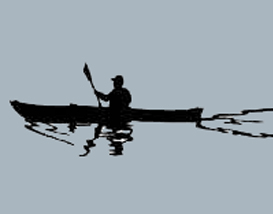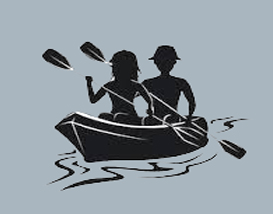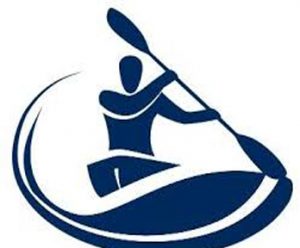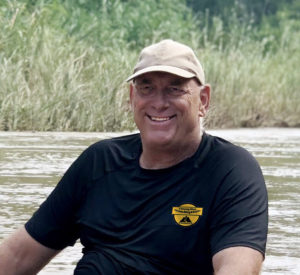Overview
Identify different currents in a river
“Eddy currents”
Effects of changing currents on the stability and directional issue of the kayak
Balance when changing currents :
Tilt your boat away from any new current you encounter, it prevents the current to hit the deck of the boat forcing it on its side.
“Hug the rock” “Lean downstream” if you are getting pushed into something by the current. This will lift the upstream side of your boat allowing the flowing water to go under the boat resulting in less pressure on the side of your boat
Enter the river, Position yourself up stream at the bow of the boat pulling your boat into the water.
How to get into the boat
( turn your back to the boat and put you behind in first and then swing your legs in ) Avoid stepping into your boat and always hold on to your paddle throughout the process.
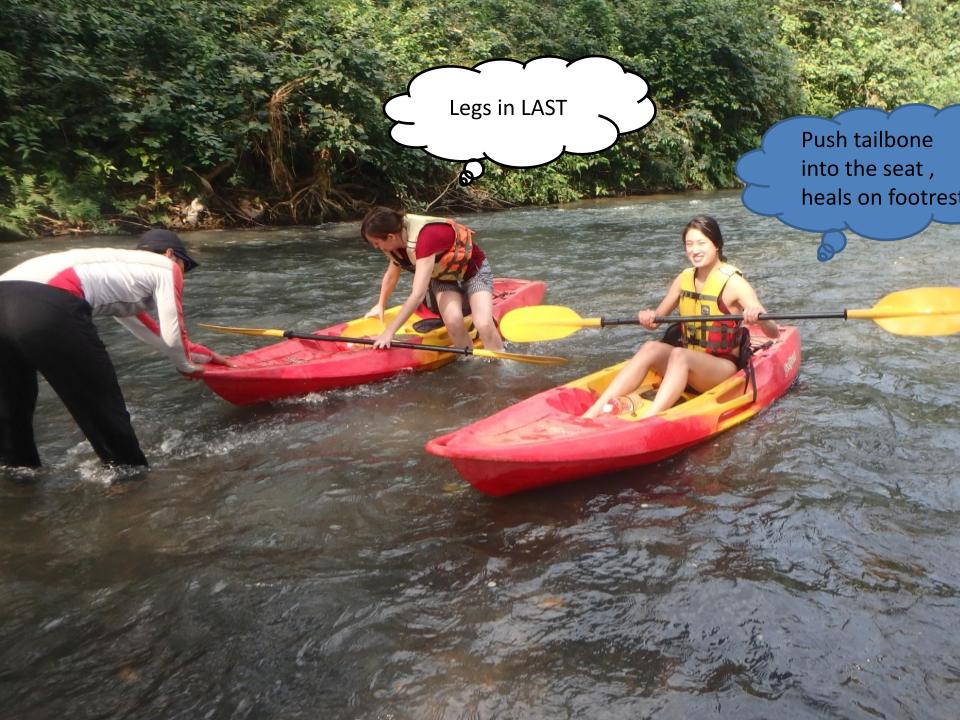
Ideal Body posture : “Combat position”
When putting maximum power into your strokes you should be sitting upright pushing your tail bone into the back rest while firmly pushing your heals into the foot rests, leaning slightly forward. This is the best way to connect to the boat.
Forward and back “sweep stroke”, “propelling strokes”

Forward sweep stroke
When planning to use your paddle stroke to turn your boat , the blade is put far away from the side of the boat to get better leverage.
Now we sweep the paddle from the front to the back . Paddle on the left , you turn right , direct command from the coach : “forward left !”
Paddle on the right, you turn left , direct command from the coach : “ forward right !”
Back sweep stroke
The back stroke is used to pivot the nose of your boat into the desired new direction and is usually followed up with a forward stroke .
Back Paddle on your right, you pivot right , direct command from coach : “back right !”
Back Paddle on your left you pivot left , direct command from coach : “ back left !”.
Practicing 360 degree turns .
Alternate Back stroke on one side and forward stroke on the other side will accomplish this.
Sharp turns
The “Ferry across” maneuver, (crossing a river)
Ferry across the river, ( getting across the river without drifting down stream) When paddling across the river current , you must point upstream in an angle towards the desired direction taking the pressure of the current in consideration . The stronger the current the steeper the angle facing upstream. Look where you want to go and adjust the angle as you drift across to get you there. Pitfall for beginners , the entry angle into the current is to shallow and the nose of the boat is pushed down stream. (make a U turn and start again)
The “Eddy Out ” maneuver, (stopping) paddle stroke associated,
TIP: Just use forward strokes on one side to initiate and complete your U-turn.
Eddy out maneuver ( stop going down stream by making a U-turn and paddling into an Eddy)
“Eddy out !” is the direct command from the coach asking to come to an immediate stop. When the U-Turn is completed you are facing upriver in a light opposite current zone (eddy) which are formed downstream of a rock, island or anything protruding into the main current . This maneuver is always accomplished by making a U -Turn.
“Eddy out left !”, is directed to an eddy on the left shore (” left” is always in relation to the current, facing down stream left ) .
“Eddy out right !”, is directed to an eddy on the right shore.
The “Peel Out ” maneuver, (reentering) dealing with oncoming current
“Peel Out”direct command from coach (leave the Eddy and enter facing the current , once completely in the current ferry across as far as you need to clear any obstacles and then back stroke to pivot downstream).
Practicing 360 degree turns .
Alternate Back stroke on one side and forward stroke on the other side will accomplish this.
4. Safety briefing and group protocol in the river
When You become a swimmer
Hold on to your paddle (if you can), lay on your back and drift with your feet pointing down stream (so you can push off and dont get your feet caught on anything ). Never stand up in strong current ! You do not need to hold on to your boat when close to shore . We will take care of your boat. Your goal is to drift and find the next eddy , turn over and swim in . Listen to coaches instructions to help you find the eddy. We will then reunite you with your boat. Other kayakers are ask to please eddy out immediately as soon as we have a swimmer.
Self Rescue in deep water
Flip the boat back over, if it is self-bailing. Hold your paddle at the opposite side of the boat parallel to the edge, pull yourself across holding the opposite edge, until you lay across the center of the boat , then flip your body over and drop your behind into the seat and swing your legs in. To make it easier you can also climb over the bow of the guides boat and slide into your boat.
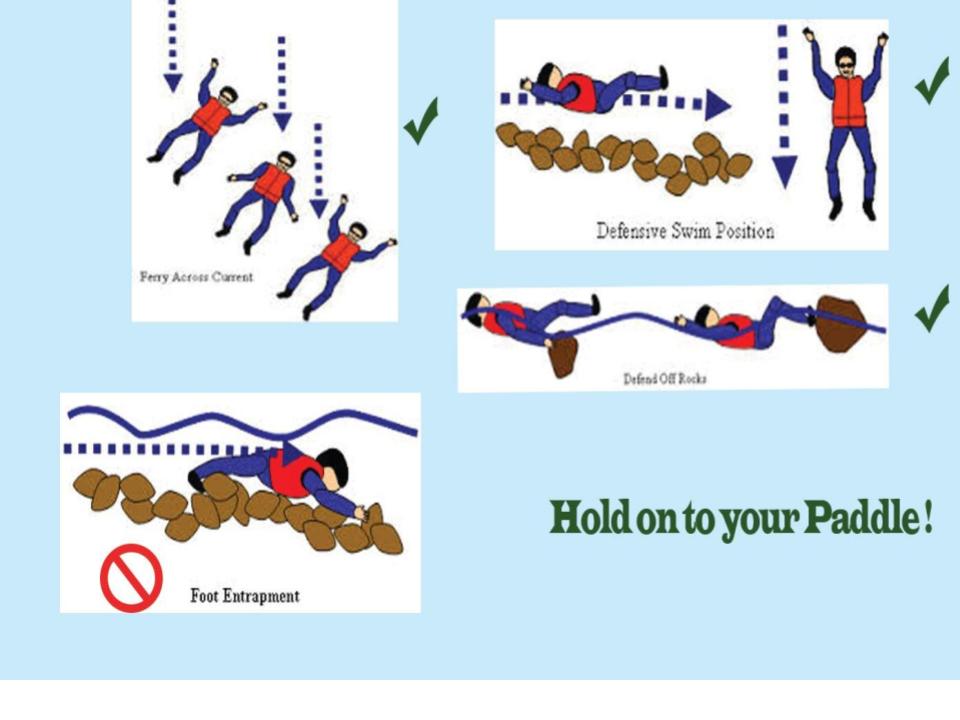
River navigation in moderate to difficult (relative) conditions.
As a group :
There is always a “Lead Guide” and a “Sweep Guide” and more depending on conditions and number of participants.
One guide enters the water first and patrols the entry line and keeps everyone upstream as the situation dictates, it is usually “Single file” behind the lead guide. Use the kayaker(s) downstream of you as reference, be sure when you enter rapids , sharp turns etc. to keep distance from your fellow kayakers to avoid a pile up. On very difficult turns etc. a guide may be facing you to observe as you enter the task, just pass, unless otherwise instructed.
Expecting a particular difficult passages the guide will ask the group to “Eddy Out” , so we can navigate 1 person at a time. A guide is positioned to assist. When it is your turn you “Peel Out “ ,be sure to wait for the GO signal (verbal, paddle signal, whistle) . After passing the hazard you are expected to eddy out , regroup until the guide can take the lead again.
To ad to your reaction time the lead guide from time to time will call out (“go left, go right” ) to point the favorable side of the river to paddle on.
When approaching a difficult passage do it cautiously but deliberately, know that you can “Eddy out” anytime you want. In Class 3 + it is very common to even stop and inspect an unknown rapid before entering. When paddling through overhanging trees etc. keep your head low leaning forward . Do not use your hand to block oncoming branches. When going through very narrow passages, you can pick up speed before hand and then glide through pointing the paddle forward using the back blade as a rudder .
These are just a few tips , when you get on the river most of this will be easier then in theory .
So don’t sweat it and have fun with it .
Looking forward paddling with you
Aidan Schmer
Director of Activities , Instructor
Chiang Mai Mountain Biking & Kayaks
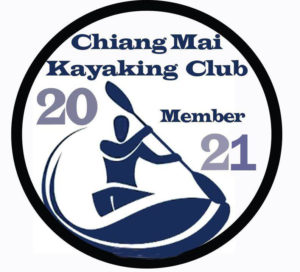
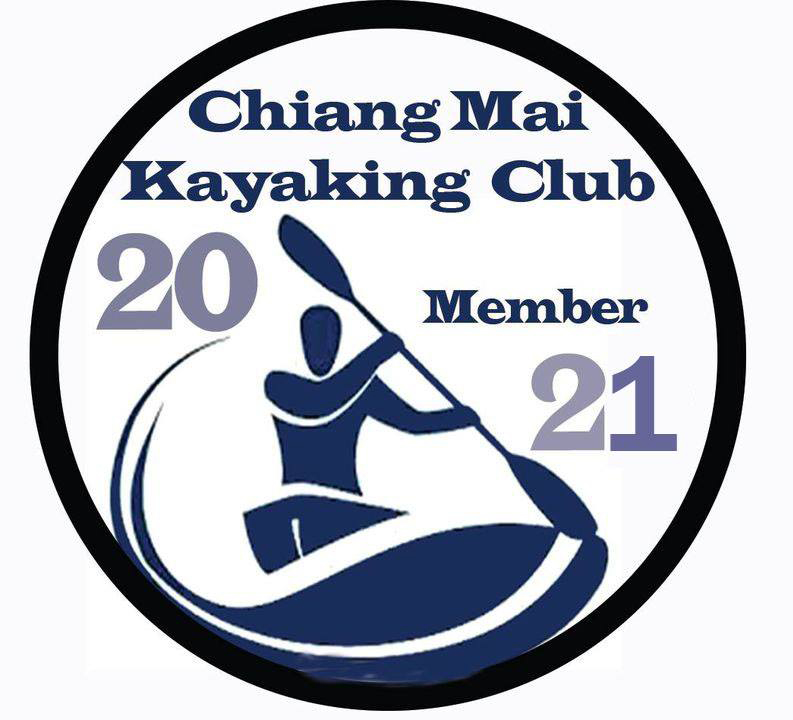
Are you curious about kayaking and would like to give it a try?
The 1-Day Sampler has been designed to give you a small taste of kayaking and hopefully “wet” your appetite for a lot more!
You will be introduced to
Adventure Level: easy .
We recommend that you be physically fit, an average swimmer and be confident in the water.
Duration: 3 hours Minimum age: 8 (with Adult supervision, share a double kayak )
10 years and up in single kayaks.
Experience: No experience necessary
Inquire about the Trip selection , joint and private rates
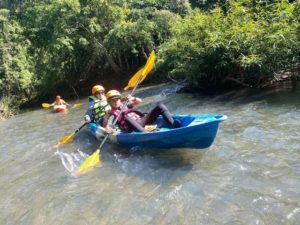
Would you like to become a whitewater paddler & are ready to take the plunge? This is the first in a series of three courses designed to teach you how to paddle whitewater. Flatwater provides a controlled environment to start learning the many skills necessary to paddle whitewater. The course will begin on flatwater and progress to moving water.
In the course of 2 Days You will be introduced to:
Basic strokes
Leaning & turning
Rolling, wet exit
Simple rescue – self & others
River etiquette
Grade 1-2 whitewater
Scouting & river hazards
Reading water
Breaking in & out of the current
Ferry glides
Adventure Level: MODERATE. We recommend that you be physically fit, average swimmer and confident in the water.
Duration: 2 days , Days can be taken individually, Minimum age: 12 years
Experience: No experience necessary
Inquire about Dates ,The River sections, joint and private rates
Have you mastered flatwater & would like to have a go at moving water?
This is the second in a series of three courses designed to teach you how to paddle whitewater. Most of the course will take place on moving water to enable you to learn and consolidate the skills necessary to control your boat on whitewater. The course will begin with a review of skills on flatwater. It will then concentrate on moving water skills in preparation for an introduction to whitewater.
Before taking part in a Beginner Movingwater Course you should:
Have completed the Beginner Flat-water Course , Program #101 or have paddled a kayak 5 – 10 times in the last year.
Be able to perform all basic strokes confidently.
Be able to paddle in a straight line on flatwater.
Be comfortable on moving water.
Be able to roll or wet exit on flatwater.
Be able to safely self-rescue.
On the course you will work on
Basic strokes
Leaning & turning
Rolling in flat & moving water
Simple rescue – self & others
River etiquette
Grade 1-2 whitewater
Scouting & river hazards
Reading water
Breaking in & out of the current
Ferry glides
Adventure Level: MODERATE. We recommend that you be physically fit, a confident swimmer
Duration: 2 days. Days can be taken individually. Minimum age: 12 years
Inquire about the Trip selection , joint and private rates
Are you ready to take on the challenge of grade >3 whitewater? This is the third in a series of three courses designed to teach you how to paddle whitewater. The course will begin with a review of skills on flat and moving water before concentrating on whitewater skills. Before taking part in a Whitewater Course you should:
Have completed Moving water Course Program # 102
or have paddled a kayak in grade 1-2 whitewater 5 to 10 times in the last year.
Be able to perform all basic strokes confidently.
Be able to paddle in a straight line on flat-water.
Be able to ferry glide, break-in & break-out on grade 2 whitewater.
Be comfortable on grade 2 whitewater.
Be able to roll or wet exit on moving water.
Be able to safely self-rescue on grade 2 whitewater.
You will work on
Basic Strokes
Leaning & turning
Rolling/wet exit in moving & whitewater
Simple rescue – self & others
River etiquette
Grade 1-3 whitewater
Scouting & river hazards
Reading water
Breaking in & out of the current
Ferry glides
Adventure Level: HIGH. We recommend that you be physically fit, a strong swimmer and be very confident in the water.
Duration: 2 days. Days can be taken individually. Minimum age: 12 years
Inquire about the Trip selection , joint and private rates
